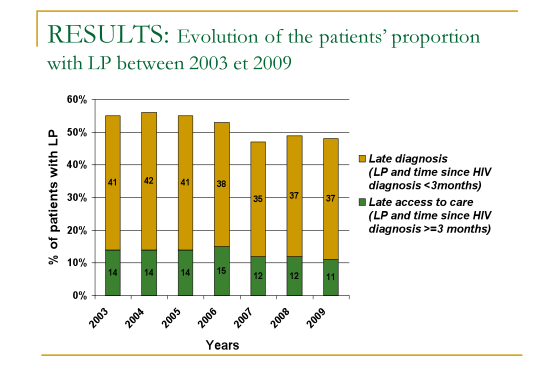 |
 |
 |
| |
Half of HIV+ in France Still Coming to Care Late--With High Death Risk
|
| |
| |
13th European AIDS Conference, October 12-15, 2011, Belgrade
Mark Mascolini
More than half of people diagnosed with HIV in France begin care with a CD4 count below 350 or AIDS, and coming to the HIV clinic late independently raised the risk of death in the first years of care [1].
Throughout the world, delayed entry to care remains an obstacle to individual HIV management and heightens the risk of HIV transmission. Many earlier studies defined late presentation as having a CD4 count below 200 or an AIDS disease. In light of recent guideline updates setting 350 CD4s as the threshold for starting antiretrovirals, a panel of HIV experts proposed changing the CD4 cutoff for late presentation to 350 [2].
This analysis of the French Hospital Database on HIV used that new definition to determine how many people came to care late and how delayed access affected mortality risk up to 4 years after care began. The analysis included 19,911 people diagnosed with HIV-1 or HIV-2 and having at least one follow-up visit since 1992. Median follow-up reached 67 months.
Prevalence of late presentation to care (CD4 count under 350 or AIDS) stood at 56% in 2004 and declined slowly through 2009, when 48% come to care late (figure). Overall, 10,586 of 19,911 cohort members (53%) entered care late. In each year 11% to 15% of cohort members came to care late and entered care 3 or more months after their HIV diagnosis.

Multivariate analysis determined that, compared with men who have sex with men (MSM), four groups had a higher risk of late presentation at the following odds ratios (OR) (and 95% confidence intervals [CI]):
-- Non-MSM migrant men: OR 2.9 (2.6 to 3.3)
-- Non-MSM nonmigrant men: OR 2.0 (1.9 to 2.2)
-- Migrant women: OR 2.5 (2.3 to 2.8)
-- Nonmigrant women: OR 1.6 (1.5 to 1.7)
Compared with people under 30, older people had higher risks of late entry to care:
-- 30 to 39: OR 1.4 (1.3 to 1.5)
-- 40 to 49: OR 2.0 (1.8 to 2.1)
-- 50 to 59: OR 2.3 (2.0 to 2.5)
-- 60 and older: OR 2.8 (2.3 to 3.3)
Compared with people who enrolled in the cohort in 2003-2004, those who enrolled in 2005-2006 had a 10% lower risk of late presentation (OR 0.9, 95% CI 0.9 to 1.0) and those who enrolled in 2007-2009 had a 20% lower risk (OR 0.8, 95% CI 0.7 to 0.8). Compared with people who lived in the Paris area, those living in French departments in the Americas were 10% more likely to seek care late (OR 1.1, 95% CI 1.0 to 1.3). But people living in other regions of France or on Reunion Island did not have a higher risk of delayed care.
Death rates 48 months after enrolling in the cohort were higher in people who had an AIDS disease when they came into care (12.7%) than in those who entered care with a CD4 count below 200 but without clinical AIDS (3.9%), those with an initial CD4 count between 200 and 350 (2.4%), and those with an initial CD4 count at or above 350 (1.2%).
To identify disease-stage variables that independently raised the risk of death, the investigators constructed Cox proportional hazard models that factored in age, gender, HIV transmission group, sub-Saharan migrant status, geographical area in France, time since HIV diagnosis, and period of enrollment or combination antiretroviral therapy.
Compared with people who entered care with a CD4 count at or above 350, people who came to care with AIDS had death hazard ratios ranging from 45.6 in the first 6 months of follow-up to 4.8 during follow-up months 12 to 48. Compared with people whose initial CD4 count stood at or above 350, those with an initial CD4 count below 200 had an 8 times higher death risk through the first 6 months of follow-up and a 2.3 times higher risk in months 12 to 48. Compared with the 350-plus group, people who came to care with 200 to 350 CD4s had a 3.1 times higher death risk in follow-up months 6 to 12 and a 1.9 times higher risk at months 12 to 48.
The French investigators believe their findings support the French Health Authority's 2009 decision to recommend HIV testing in the general population. Because of the high death risk with delayed care, the researchers called for "specific management of patients with late presentation especially in the first 6 months."
References
1. Montlahuc C, Guiguet M, Abgrall S, on behalf of FHDH ANRS CO4. Impact of delayed access to care (with AIDS or CD4< 350/mm3) on the risk of death in HIV-infected people in France (2003-2009). 13th European AIDS Conference. October 12-15, 2011. Belgrade. Abstract PS8/6.
2. Antinori A, Coenen T, Costagiola D, et al. Late presentation of HIV infection: a consensus definition. HIV Med. 2011;12:61-64. http://onlinelibrary.wiley.com/doi/10.1111/j.1468-1293.2010.00857.x/full.
|
| |
|
 |
 |
|
|